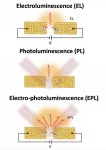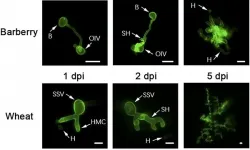(Press-News.org) Metformin, a drug used to treat type-2 diabetes, could help reduce chronic inflammation in people living with HIV (PLWH) who are being treated with antiretroviral therapy (ART), according to researchers at the University of Montreal Hospital Research Centre (CRCHUM).
Although ART has helped improved the health of PLWH, they are nevertheless at greater risk of developing complications related to chronic inflammation, such as cardiovascular disease. These health problems are mainly due to the persistence of HIV reservoirs in the patients' long-lived memory T cells and to the constant activation of their immune system.
In a pilot study published recently in EBioMedicine (URL), Université de Montréal immunology professor Petronela Ancuta and first author Delphine Planas, a PhD student in her laboratory at the CRCHUM, evaluate the ability of metformin to improve immune function and reduce viral reservoir size.
We asked Professor Ancuta to explain the study.
Q. Despite the use of antiretroviral therapy, seropositive individuals exhibit immune activation and excessive inflammation. In your study, you try to stop that with metformin. How so?
Currently, antiretroviral therapies inhibit HIV replication by preventing the entry of virion (a complete viral particle) into new cells and its exit from infected cells. However, one step is still not targeted by these therapies: the multiplication of the viral genome inside the infected cell.
Despite antiretroviral therapy, this intracellular viral multiplication causes chronic inflammation and immune activation, leading to the emergence of co-morbidities such as cardiovascular disease. In the laboratory, we are working to identify new treatments to inhibit intracellular viral multiplication.
The idea of using metformin in people living with HIV came from Dr.?Jean-Pierre Routy of the Research Institute of the McGill University Health Centre, our collaborator in this study. Used widely in medicine, this drug stimulates or inhibits the reactions of the body's immune system.
In our study, knowing that metformin interferes with the activity of the mTOR (mechanistic target of rapamycin) molecule involved in the intracellular multiplication of HIV genome, we used the drug to treat 22 nondiabetic PLWH on antiretroviral therapy (13 in Montreal and nine in Ottawa). In vitro, studies by our group and others had previously demonstrated that inhibiting mTOR with drugs inhibits HIV replication considerably in the cells of patients infected by the virus.
Q. Did the results of your study surprise you?
Yes, we were excited by the positive results of this pilot study. The drug was extremely well tolerated by the patients and we observed the beneficial biological effects of metformin in colon biopsies.
HIV hides in CD4 T cells, immune system cells that shelter the virus and form viral reservoirs in various peripheral tissues such as the intestine. The virus continues to multiply in these reservoirs and leads to inflammation.
In the study, we observed a reduction in the activation of mTOR in CD4 T cells present in the colon, as well as a decrease in certain plasma markers of inflammation and intestinal damage. Metformin, then, has both intestinal and systemic effects.
Q. HIV reservoir size is linked to the level of inflammation. Could new approaches like yours reduce the size of these reservoirs? Did you observe this in your study?
The viral DNA reservoir size in peripheral blood T cells and in the colon was pretty stable, which is consistent with the known stability of HIV reservoirs. However, we expect that longer treatment may lead to a reduction of these reservoirs. This hypothesis is worth testing.
Q. Will you continue your research with a larger patient sample?
We're going to launch a new randomized study on more than 58 participants in which metformin will be administered over a longer period. We're planning to do it over a six- to 12-month period to validate the benefits of metformin in controlling inflammation, in part by regulating mTOR.
To conclude, I would like to thank the participants in the LILAC study for donating their biological samples and believing in our research efforts, which came to fruition thanks to close collaboration with many researchers, particularly the teams of Drs.?Jean-Pierre Routy and Maged Peter Ghali (McGill University Health Centre), Nicolas Chomont (CRCHUM) and Dr.?Jonathan Angel (Ottawa Hospital Research Institute).
INFORMATION:
About this study
"LILAC pilot study: effects of metformin on mTOR activation and HIV reservoir persistence during antiretroviral therapy" by Delphine Planas et al, was published March 1, 2021 in The Lancet's eBioMedicine journal. The study was funded by the Canadian Institutes of Health Research, the Fonds de Recherche du Québec-Santé, CanCURE and the Fondation du CHUM.
MADISON, Wis. -- Scientists at the University of Wisconsin-Madison have developed a way to use a cell's own recycling machinery to destroy disease-causing proteins, a technology that could produce entirely new kinds of drugs.
Some cancers, for instance, are associated with abnormal proteins or an excess of normally harmless proteins. By eliminating them, researchers believe they can treat the underlying cause of disease and restore a healthy balance in cells.
The new technique builds on an earlier strategy by researchers and pharmaceutical companies to remove proteins residing inside of a cell, and expands on this system to include proteins ...
For the first time, scientists have documented biofluorescence in an Arctic fish species. The study, led by researchers at the American Museum of Natural History who spent hours in the icy waters off of Greenland where the red-and-green-glowing snailfish was found, is published today in the American Museum Novitates.
"Overall, we found marine fluorescence to be quite rare in the Arctic, in both invertebrate and vertebrate lineages," said John Sparks, a curator in the American Museum of Natural History's Department of Ichthyology and one of the authors of the ...
The ongoing COVID-19 pandemic changed the higher education experience for students across the United States, with more than 90 percent of institutions reporting a shift in education delivery with the arrival of COVID-19.
The rapid transition to remote study came with its own learning curve for students and faculty alike. But for many students with disabilities, the shift offered new educational modalities as well as challenges - and the hope that some changes will continue after the threat of the virus subsides.
"This was a really unique, historical moment," says Nicholas Gelbar '06 (ED), '07 MEd, '13 Ph.D., an associate research professor with the Neag School of Education. "Remote learning, ...
Millions of children weighing less than 15kg are currently denied access to Ivermectin treatment due to insufficient safety data being available to support a change to the current label indication. The WorldWide Antimalarial Resistance Network (WWARN)'s new meta-analysis published today provides evidence that supports removing this barrier and improving treatment equity. ...
DURHAM, N.H.-- Researchers at the University of New Hampshire have found that more than 50% of children in high-risk populations in the United States are not receiving behavioral health services that could improve their developmental outcomes when it comes to mental and physical health problems.
In their END ...
HOUSTON - (March 18, 2021) - If you're looking for one technique to maximize photon output from plasmons, stop. It takes two to wrangle.
Rice University physicists came across a phenomenon that boosts the light from a nanoscale device more than 1,000 times greater than they anticipated.
When looking at light coming from a plasmonic junction, a microscopic gap between two gold nanowires, there are conditions in which applying optical or electrical energy individually prompted only a modest amount of light emission. Applying both together, however, caused a burst of light that far exceeded ...
When it comes to recreational crabbing--one of the most iconic pastimes along Maryland's shores--the current estimate of 8% of "total male commercial harvest" runs just a little too low. Biologists, with local community support, found stronger evidence for the underestimate in the END ...
As one of the founding members of the International Rye Genome Sequencing Group (IRGSG), the University of Maryland (UMD) co-published the first full reference genome sequence for rye in Nature Genetics. UMD and international collaborators saw the need for a reference genome of this robust small grain to allow for the tracking of its useful genes and fulfill its potential for crop improvement across all major varieties of small grains, including wheat, barley, triticale (a cross between wheat and rye that is gaining popularity), and rye. Following the model of international collaboration used ...
Wheat stripe rust is one of the most important wheat diseases and is caused by the plant-pathogenic fungi Puccinia striiformis f. sp. tritici (Pst). Though Pst is known to be highly host-specific, it is interestingly able to infect two unrelated host plants, wheat and barberry, at different spore stages. Pst infects wheat through its urediniospores and infects barberry with its basidiospores.
"This complex life cycle poses interesting questions on the co-evolution between the pathogen and the hosts, as well the different mechanisms of pathogenesis underlying the infection of ...
The Journal of Anthropological Research has just published a new article on the development of linguistic documentation among heritage language speakers: "Articulating Lingual Life Histories and Language Ideological Assemblages: Indigenous Activists within the North Fork Mono and Village of Tewa Communities."
Specifically, it focuses on the biographical information of individual speakers, and the significance they place on the language in question. Author Paul V. Kroskrity focused his research on two specific communities - the North Fork Rancheria of Mono Indians in California and the Village of Tewa, First Mesa, Hopi Reservation in northeastern Arizona ...




